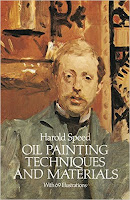 Today we'll continue Chapter 9: "Painting from the Life" from Harold Speed's 1924 art instruction book Oil Painting Techniques and Materials
Today we'll continue Chapter 9: "Painting from the Life" from Harold Speed's 1924 art instruction book Oil Painting Techniques and MaterialsI'll present Speed's main points in boldface type either verbatim or paraphrased, followed by comments of my own. If you want to add a comment, please use the numbered points to refer to the relevant section of the chapter.
Today we'll cover pages 144-157, "On Painting a Head."
 |
| Harold Speed, Old Tom, courtesy BBC |
This is good advice that will reduce confusion, eliminate habits of color mixing, and yield harmony in the final result.
2. Don't take the colors as they come from the tube; Mix your own colors.
Also a good idea. You can create your gamut primaries, instead of using the colors as they happen to come from the tube. So here you're not mixing the particular notes of your scene, but rather you're mixing the ingredients of your color scheme. Instead of using yellow ochre and cad yellow as separate palette colors you can mix the two, and then use that mixture as your gamut anchor. For example he recommends mixing Indian red and burnt sienna. This is what the manufacturers do, mixing pigments to get convenience colors.
3. "The paint as supplied in tubes is a little stiffer than is always comfortable to paint with, and it is as well to thin the white by mixing up some of your medium with it."
I find the opposite is often a problem with modern paint. Paint often comes out of the tube too runny. In that case you can stiffen tube colors by first placing them on blotter paper (or other absorbent paper or cardboard) a few hours before you need to use them. As Speed suggests, it's good to have some "stiff white" about the consistency of butter always available on your palette for impasto-rich highlights.
4. Sequence: background, hair, forehead (middle tone), planes of lower face, eye socket, nose, highest light in forehead, etc.
It might seem difficult to follow this procedure in the form of text, given that we're used to seeing videos that show the process much more clearly. But try to visualize it. This is close as we're going to get to a time machine back to the Royal Academy.
5. "In the case of a short portrait sitting...do not attempt any more complications in your tones. Keep them flat and simple at first."
Put your work into refining the edges instead of refining the tones. I would say to think of the head as a roughly carved block at this stage, and rejoice that there aren't too many details to worry about.
6. "Always paint with the least amount of paint that will get the effect you want. Reserve thick paint for those occasions when you want to make a crisp touch quite separate from what it is painted into."
For beginning painters there's a lot to think about when you mix a color: value, color temperature, hue, chroma, and now you've got to think about paint thickness, not to mention what brush to use, etc. As you read Speed talking about his thought process, note what considerations are foremost at each stage. Value judgments are most important at first, then edges become vitally important, then he's thinking about warm versus cool differences.
7. Carefully define the eye sockets before detailing the eye.
Speed probably learned this method from watching Sargent, who was said to paint an eye in this way, like making a frying pan (eye socket) and dropping an eye into it (the egg). Later Speed says: "Remember the eye is a cavity, through which is pushed the globe of the eye, on which the eyelids are placed. The eyelids therefore partake of the spherical form, as do also the 'whites' of the eye."
8. "You should always talk to your sitters if you want to keep them alive."
Many first hand sources attest to the fact that portrait painters of the past talked to their models while they painted them. This is one of the most important points that is generally missed by modern practitioners. It makes all the difference in the disposition of the face and the expression of the model. Sleepy, dull models yield sleepy, dull portraits. Talking models yield portraits that are alive. There's no getting around it. Here's a previous blog post "Talking Models" on the topic and another post "Speaking Likeness" on the same subject.
 |
| Detail of a portrait by Velazquez |
To find some examples of plane breakdowns as suggested in the detailed discussion on pages 153-155, such as the "three cherries" of the lips, etc. I recommend the anatomy books by Vanderpoel, Loomis, Peck, and others.
10. "Having laid in your work with the muted middle tones, you will be able to use much purer colour in the later stages, as they will be quieted by mixing with the middle tones already there."
 |
| Portrait by Harold Speed |
Try to accomplish what Speed calls oneness of impression, and look for that quality in the great portraits of Sargent, Velazquez, and Rembrandt. Accents are last, and you can think of the whole head painting as a setup for those last highlights and accents.
 Next week—we'll continue with the chapter with the section beginning on 157.
Next week—we'll continue with the chapter with the section beginning on 157.
-----
In its original edition, the book is called "The Science and Practice of Oil Painting ." Unfortunately it's not available in a free edition, but there's an inexpensive print edition that Dover publishes under a different title "Oil Painting Techniques and Materials
." Unfortunately it's not available in a free edition, but there's an inexpensive print edition that Dover publishes under a different title "Oil Painting Techniques and Materials (with a Sargent cover)," and there's also a Kindle edition.
(with a Sargent cover)," and there's also a Kindle edition.
----GurneyJourney YouTube channel
My Public Facebook page
GurneyJourney on Pinterest
JamesGurney Art on Instagram
@GurneyJourney on Twitter








6 comments:
On 8: We rarely talk to the model! Why is this? Focusing on the painting? A strange societal discomfort with the undraped figure? I know that the figure sessions that have been most comfortable to me are where teacher, student, and figure can all enjoy a relaxed, open, atmosphere. We need to bring this back!
#9: I'm still a total newb at portraits, but I was atrocious with eyes so I did a few studies to warm up and learn. I found the book The Artist's Complete Guide to Drawing the Head by William Maughan to be very helpful in learning the structure of the eye. Applying this to an actual live model portrait has been difficult, but hopefully I'll avoid the worst mistakes by the time I wrap up this first attempt!
Another timely and informative post. Thanks once again for bringing us all along on your Journey!
#11 I found that the key moment - the highlights, is best left to when you (and the sitter) are at your freshest. It's a sweaty palms moment.
#3 Paint consistency is an obsession of mine and never more so than in the final stages. In my shambolic study of Rembrandt I found that a good, translucent, buttery quality could be had by mixing Cremenitz white (stiff lead white) with egg yolk/damar varnish and stand oil. The quantity of yolk to paint/medium was tricksy - it "puts up" very quickly - but the effect is very 17th century. Reserved for the highlights only, with maybe a glaze over the top. Recipes can be found in 'The Artists Handbook of Materials and Techniques by Ralph Mayer'
Really enjoy these tutorials James. Speed and your commentary are the full bottle. Inspired to maybe trot out the oils again.
Thanks for the color photo of "Old Tom." Harold Speed is part of the foundation of my painting practice, but I've seldom seen any of his work in person, or in color. Actually, the only time I've seen his work in the flesh was in India, at the Prince Regent's museum, in Bombay.
I allways wondered who did the painting on the cover of Speeds book (the paperback edition anyway)?
Mezzotint, that portrait was by John Singer Sargent, who Speed probably knew at the Royal Academy.
Craig, Yes, the photo of the Old Tom painting is a bit on the yellow side.
Ross/ Bobby, Thanks for those formulations. Good to save those highlight moments until the end when the model and artist are both fresh.
Zach, It's actually hard to imagine painting a model with eye contact unless you're talking to them. But I suppose talking without eye contact is certainly doable, even with nude models (depending on what you're talking about). Always good to clear such things in advance with all parties (models and other painters) of course.
Cashwiley, glad it's helpful. Practicing eyes = good idea.
Post a Comment